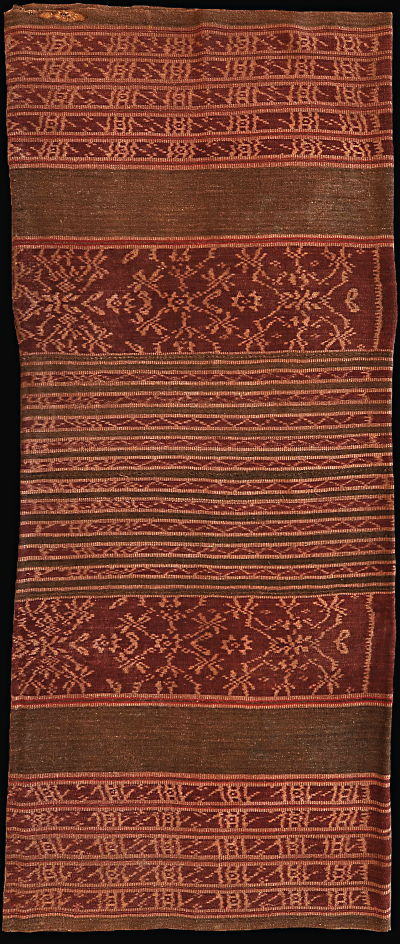| |
 
 | | | |
318 Roti Group, Ndao
Pou (sarong)  
| | | Period: | 19th or early 20th c. | | Yarn: | Cotton, hand-spun, medium, and silk pinstripes | | Technique: | Warp ikat | | Panels: | 3 | | Size: | 105 x 125 cm (3' 5" x 4' 1") LW: 1.19 | | Weight: | 565 g (19.9 oz), 430 g/m2 (1.41 oz/ft2) | | Design: | Red sarong of a type that is practically unknown. James J. Fox: 'The rarest of all cloths from Ndao are the traditional sarongs of the women of the Lesser Clans for they completely reverse the background color of the majority cloths. They are a beautifully shaded red with white and possible some blue for design and contrast. These cloths, even more than their male counterparts, recall the flesh and blood of Figure Shark and Pattern Crocodile.' The two widest bands of this example carry patola-inspired jilamprang motifs drawn in a slightly angular style, which fits the general approach to drawing on both Ndao and Roti. The heart of some of these jilamprang motifs is an eight-pointed star, a motif that is also used as fillers between some adjacent jilamprang. The use of the eight-pointed star on a cloth from Ndao was not previously recorded. The second widest bands, at the extremities, each carry five stripes with unknown small motifs separated by vertical dividers. The midfield is formed by ten stripes with a zigzag motif. Twenty-eight pinstripes, merely four threads wide (quad-ply silk) accentuate the overall red appearance. | | Comment: | The dimensions given reflect that the sarong (here shown in its original form as a tubeskirt) was opened up for display, probably in colonial days, as the yarn used to seam off the opened up panels, is old hand-spun. One side is very lightly faded, suggesting that for some time it was on display, perhaps used as cover for a kot or a tea table. The cloth is largely whole, but there are spots where it wore thin, and one old repair at a bottom edge. Microphotography reveals the wildly irregular yarn that is typical for 19th and very early 20th ikat. This cloth, like the kewatek kenirek miten of Ili Mandiri on Flores tells a type of Cinderella story. Locallly these cloths from the Lesser Clans were not esteemed as highly as cloths made by the leading clans, so never offered for sale - because roving field collectors always insisted that they wanted to be offered only the very best, yang istimewa. Now nearly all of those lovely red cloths of the Lesser Clans are gone and must now be counted among the rarest of all Indonesian textiles. | | Background: | Chapters on Roti Group and Ndao. | | Published: | Ikat from Timor and its Outer Islands, 2022.
| | Sources: | A similar sarong is depicted in Maxwell, Southeast Asian Textiles, Fig. 517. The long caption based on Fox (pers. comm.) stresses its rarity and high ranking, signale by the patola-inspired motif. A similar, though probably younger example is depicted in McIntosh, Thread and Fire, Fig. 7.34. There is one 2-panel (rather than 3-panel) red sarong with supplementary weft decoration identified as Rote (Roti, Ndao's somewhat larger neighbour) in the old Rotterdam Wereldmuseum collection, WM-45305, which at first glance looks similar, but on closer inspection it appears more likely to have been made on Raijua (Cf. PC 104) where 2-panel construction is the norm and supplementary weft quite common. James J Fox in Mattiebelle Gittinger, ed., Indonesian Textiles, p. 48, mentions such red sarongs, as quoted above, but does not depict one. | | |

©Peter ten Hoopen, 2025
All rights reserved.
|
|


